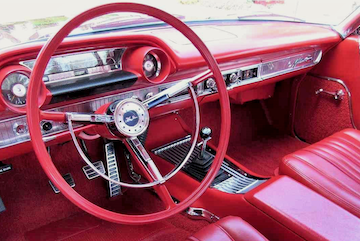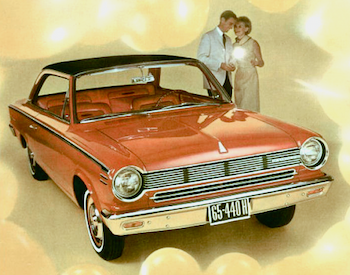
Like the paradox of Schrödinger’s Cat, simultaneously alive and dead, the Oldsmobile division of General Motors introduced a wheel option for their 1964 Starfire and Jetstar I models that was both real and unreal.
Continue reading
Like the paradox of Schrödinger’s Cat, simultaneously alive and dead, the Oldsmobile division of General Motors introduced a wheel option for their 1964 Starfire and Jetstar I models that was both real and unreal.
Continue reading
It’s hard not to notice how exhaust tips have evolved into fetish items over the past decade-and-a-half. Overly stylized and comically oversized, they have become carbuncles defacing the stern of the majority of mid and upper-range vehicles currently on offer.
Continue reading
It could be argued that the first automobile designs to seriously address efficient space utilization were the prewar Fiat Topolino, and the postwar Fiat 600 and Citroën DS; both the latter introduced in 1955.
Continue readingJames Kraus

Stick (noun). Any of various implements resembling a stick in shape, origin, or use: such as the gearshift lever of an automobile.
Since time immemorial, American enthusiasts have declared their love of, or mastery over, a mysterious object called a “stick shift.” It’s a strange term. The fact is, since the demise of the Ford Model T and its pedal-operated planetary gearbox, the vast majority of cars (until recently) have featured transmissions whose gears or driving ranges are selected by means of a “stick” usually mounted on the floor or steering column.
Continue reading
James Kraus
The heyday of Pontiac neatly coincides with the 1960-1967 period most celebrated here at Auto Universum. Their glory days began with the formation of a young new team of executives who were granted control of the division in the late fifties.
Continue readingJames Kraus

A Flathead engine, with its valves ensconced in the block, was still a competitive design in the low-compression, low-speed engines of the prewar era. That changed and changed quickly with higher-octane fuels allowing for higher compression ratios, and improved metallurgy and shorter-stroke engine designs enabling considerably higher crankshaft speeds.
The large-volume combustion chambers and upside-down valve placement required in a flathead engine conspired to limit the compression ratio to around 8.4:1, after which power and fuel efficiency both decreased.
Continue readingJames Kraus

1961 Pontiac Catalina with the original 8-Lug wheel; introduced mid-1960.
American cars of the 1960s were certainly not renowned for their braking prowess. Except for a handful of exceptions, disc brakes were not widely available until 1967 and the drum brakes provided were generally small in size and nowhere near up to the weight and power of the cars to which they were fitted. Continue reading
James Kraus

1964 Pontiac GTO Sports Coupe in Sunfire Red metallic. Equipped with optional triple dual-throat carburettors, four-speed all-synchromesh gearbox and Safe-T-Track.
Few things warm the hearts of Car Nutz like good punchy buzzwords. Favourites of American car fans include Muscle Car, Big Block, and today’s topic; Positraction. Continue reading
James Kraus

1966 Toronado by Oldsmobile.
The 1960s were the final years of glory at General Motors. They had the lion’s share of the U.S. car sales, as well as a good portion of the European market via their Opel and Vauxhall brands. In the U.S, they built America’s only cars with four-wheel disc brakes, fuel injection, turbocharging and independent rear suspension. Before the decade was out, they would add another arrow to their quiver, the first American postwar car with front-wheel drive. Continue reading
James Kraus

U.S.-spec 718 Boxster. Is the driver braking? Turning? Who knows? Who cares? Porsche doesn’t; but you should.
Everywhere outside of North America, rear turn indicators are required to be amber in colour. This is due to extensive research going back decades demonstrating amber conclusively outperforming red in terms of recognition time. The latest studies by the NHTSA in 2008 and 2009 show a significant reduction in collisions when vehicles are equipped with amber rear indicators (assuming of course that drivers actually use them.) Continue reading
James Kraus

Unsafe At Any Speed, Ralph Nader. First Edition; November, 1965.
Fifty years ago, new 1968 autos sat glistened in showrooms across America. These were a bit different from previous new cars; for the first time in history their design was heavily influenced by U.S. government regulations. New federal legislation required reductions of harmful vehicular emissions, and increased safety for drivers and passengers. Today Auto Universum looks back at the history of automotive safety design and the background of the numerous safety features that greeted new U.S. car buyers in 1968. Continue reading
James Kraus

1964 Chevrolet Impala.
Fifty years ago, new 1968 autos began appearing in showrooms across America. These were a bit different from previous new cars; for the first time their design was heavily influenced by the U.S. government. New federal regulations covered two key areas of automotive engineering with twin goals in mind: a reduction of harmful vehicular emissions and increased safety for drivers and passengers. Today Auto Universum looks back at the early years of emission reduction. Continue reading
James Kraus

Don Draper in his Starlight Silver 1965 Cadillac Coupe de Ville.
One of the few value segments of the vintage car market is what Auto Universum calls American Glamour. A lack of enthusiasm for refinement and elegance has kept prices subdued, a welcome state of affairs waiting to be exploited by those who with a taste for the good life. Continue reading
James Kraus

Automatic Electric Mobiltel car phone brochure, 1960
In the early decades of motoring; if you wanted to make a phone call while on the road, you pulled over, parked and fed coins into a public telephone.
Civilian in-car mobile telephones were first introduced in the 1940s. By the 1960s new models were developed incorporating significant improvements. Chief among these was the general rollout of full duplex operation allowing both parties to speak simultaneously. Full duplex phones obviated the need for a push-to-talk button in the handset and over and out-style communication. Another major advance, direct dialling, became available by mid-decade in selected markets. Continue reading
James Kraus

1967 Porsche 911S
Porsche and the rear window wiper are inexorably linked in the annals of automotive history. And for good reason. Continue reading
James Kraus

1965 Cadillac Calais
Clear tail lights are quite popular today and appear on several new models as standard or optional equipment from the Toyota Prius to the Porsche 911 and Aston Martin Vantage. Many people mistakenly believe they were introduced in 1998 with the debut of the Toyota Altezza (Lexus IS) although the Toyota actually only had conventional tail lamps covered by clear acrylic; the design did not conceal the underlying red filter lenses. Clear tail lamps, like so many automotive technologies, actually first surfaced in the 1960s. Many of them were more sophisticated than some recent examples. Continue reading
by James Kraus

Ferrari 250 GTO
While aerodynamic efficiency was occasionally a consideration in the design of road cars as early as the 1920s, it was only from a perspective of achieving reduced air resistance. Interest in generating aerodynamic downforce did not manifest itself until the 1960s. Not surprisingly, experimentation and development first occurred in the competition arena. Continue reading
by James Kraus

Koni adjustable damper at the front of a Porsche 356C
One of the disparities in the automotive lexicon is the term bestowed upon the damper/shock absorber. In Germany and the majority of the English speaking world, it’s a damper. In the U.S., France, Italy and Spain, it’s a shock absorber. Deciding which is the more correct designation depends to a large degree on the era under discussion. Continue reading
by James Kraus

Air France Aérospatiale-BAC Concorde
Paying homage to its Jet Age subtitle, today Auto Universum takes to the skies in celebration of three significant milestones in jet travel that occurred in the final year of the 1960s: the initial flights of the Boeing 747, Playboy DC-9 and Concorde. Before examining these, it is worth a glance back to the very birth of the Jet Age.
World War II was the first major battle whose outcome was largely determined by air superiority. Airplanes had come a long way since WWI in aeronautics, airframe design and propulsion. Aircraft designers soon realized that further speed increases were being held back by the limitations of engine-driven propellers, the efficiency of which falls sharply as blade tip rotational speed approaches Mach 1.0. Continue reading
by James Kraus

World’s first Wankel-powered production car: the NSU Spider, 1964
Automobiles can trace their reciprocating-piston engines back to the early days of steam power. As internal combustion replaced steam as the preferred method of powering transport, the concept of using reciprocating pistons to convert energy into motion was carried over.
As the automobile matured, the efficiency and operating smoothness of the reciprocating piston engine gradually improved through the use of a multiplicity of smaller cylinders, shorter piston strokes, counterbalanced crankshafts and other refinements. By the dawn of the 1960s however; the automobile was seemingly falling behind aviation, which had switched to smooth continuous-combustion jet engines. A number of auto manufacturers experimented with gas turbine engines, but none entered mass production.